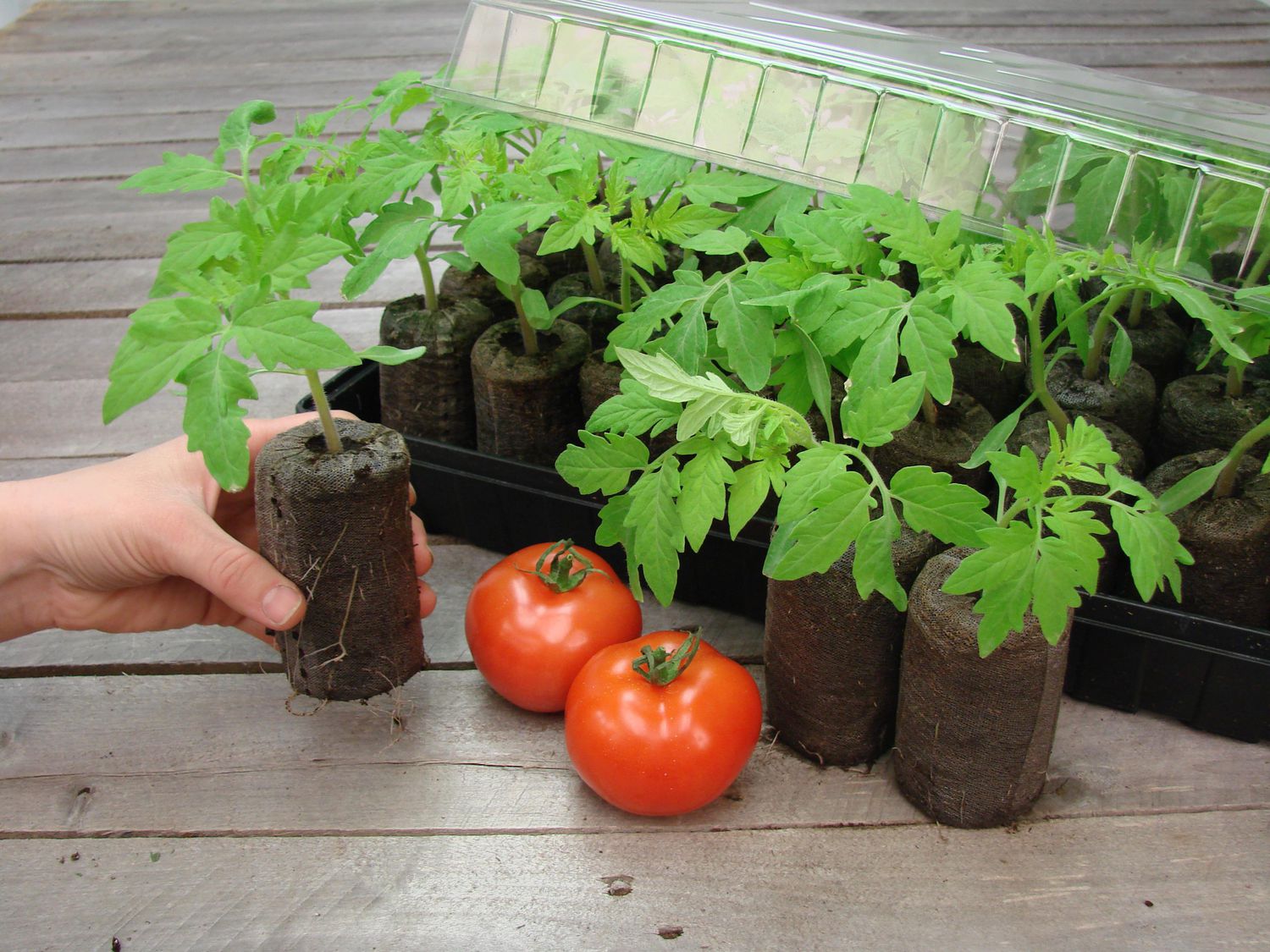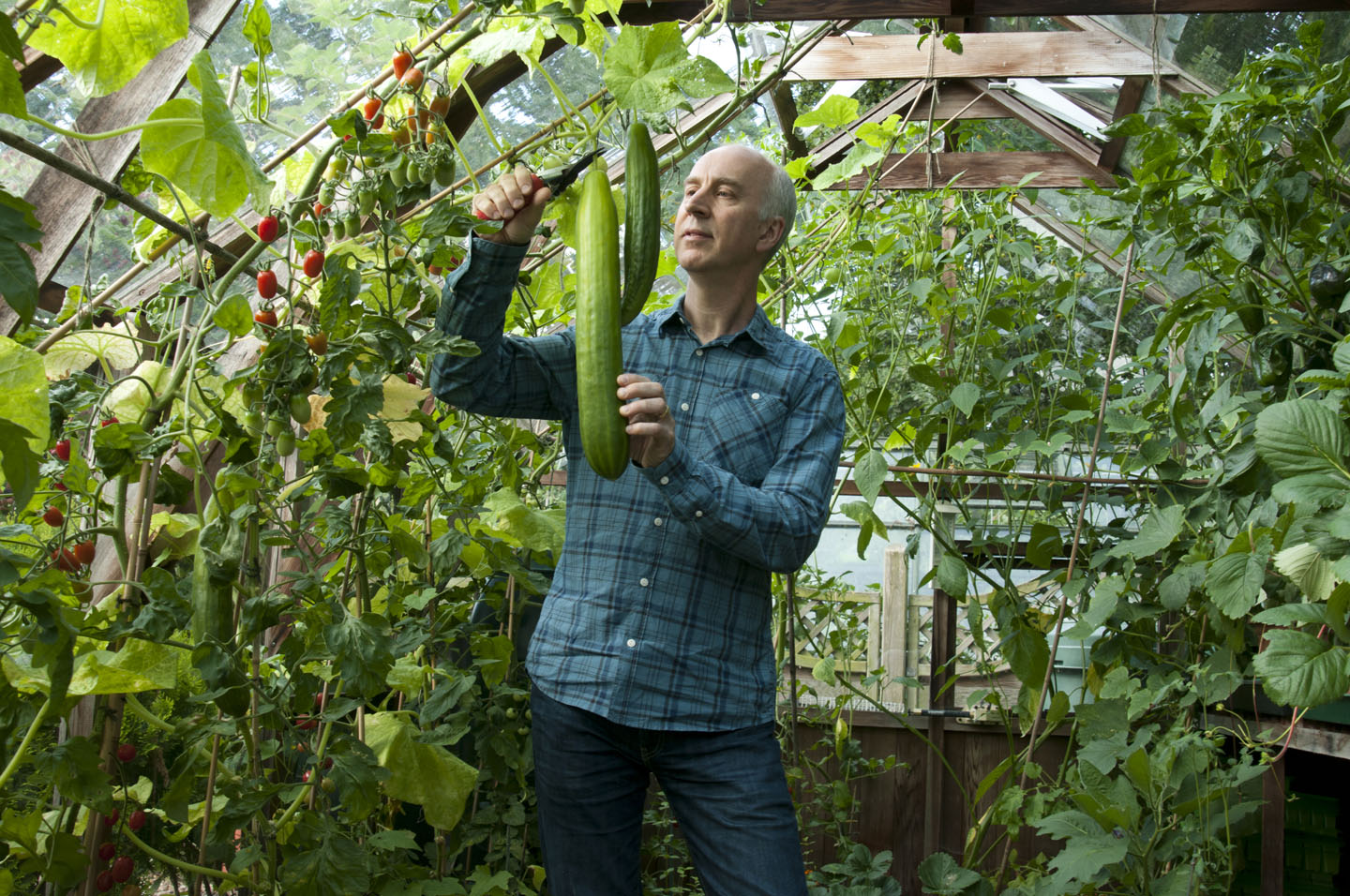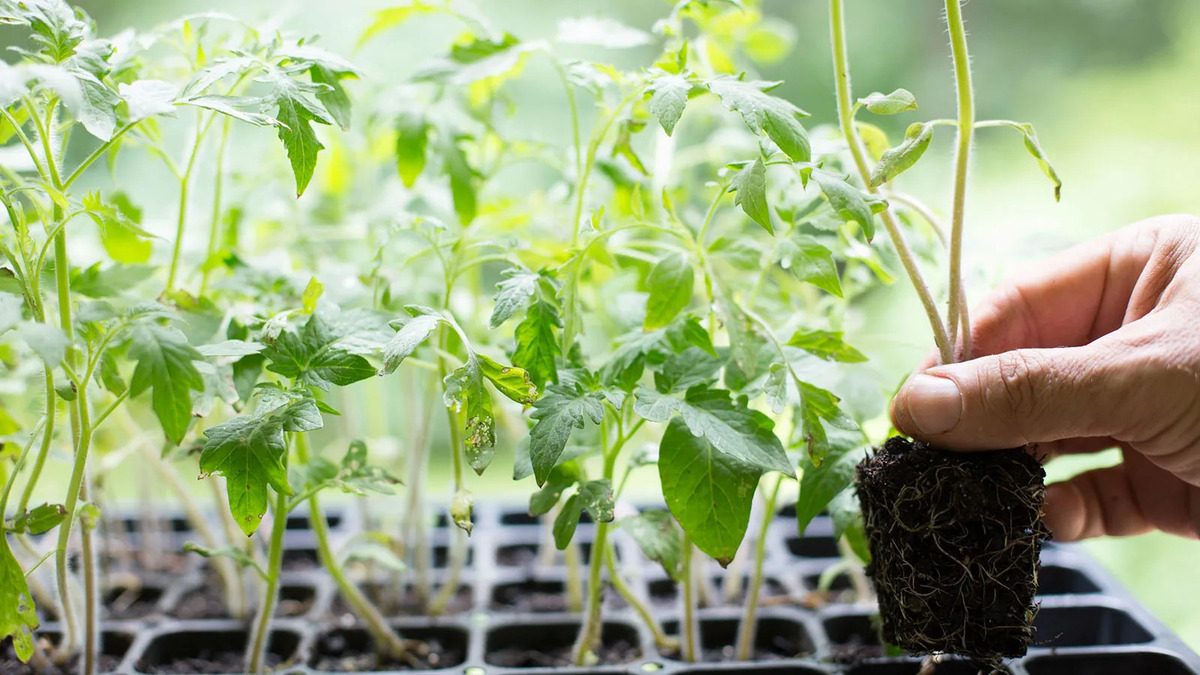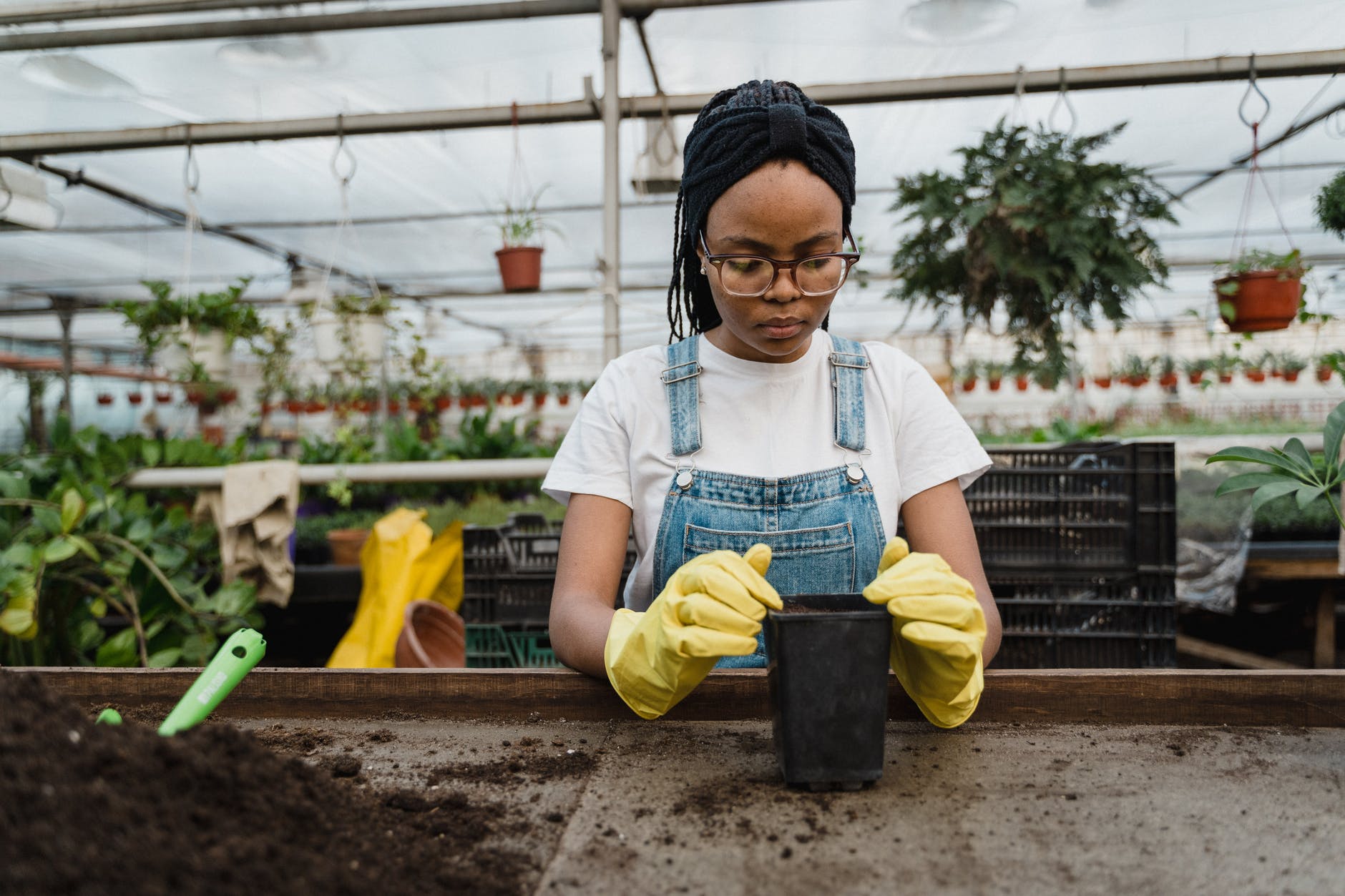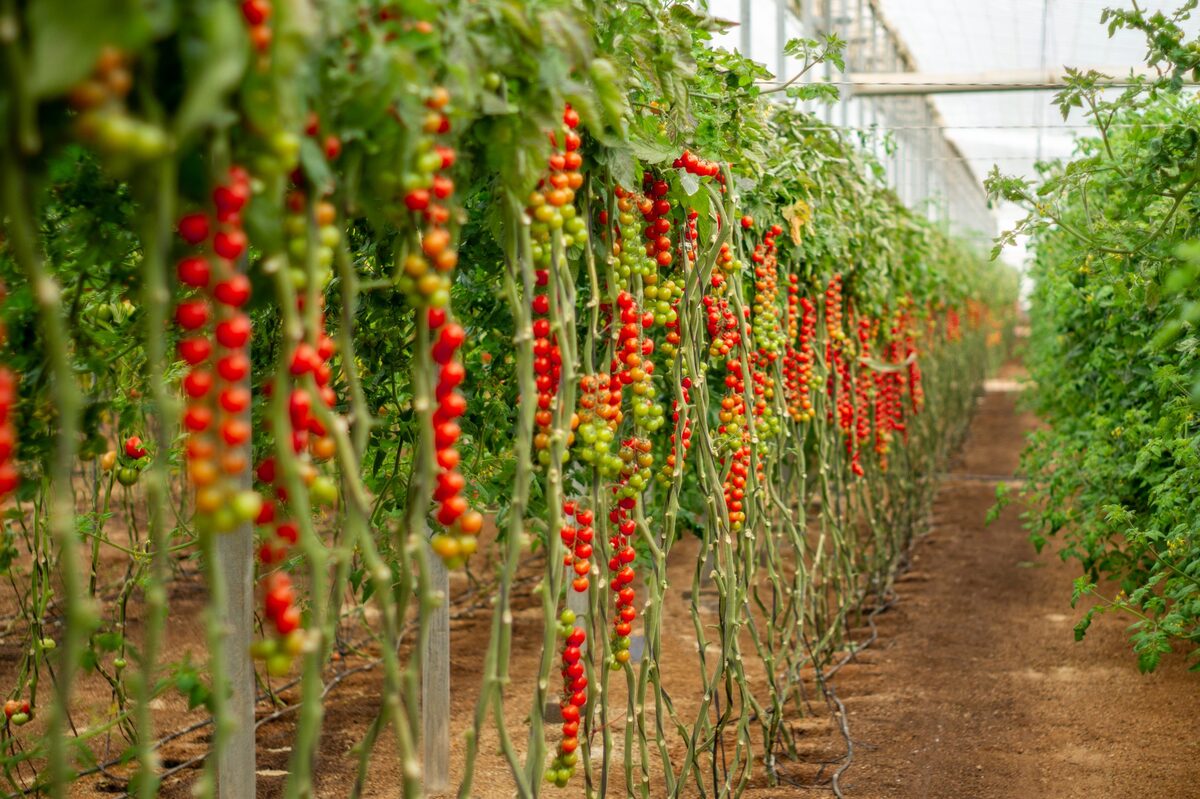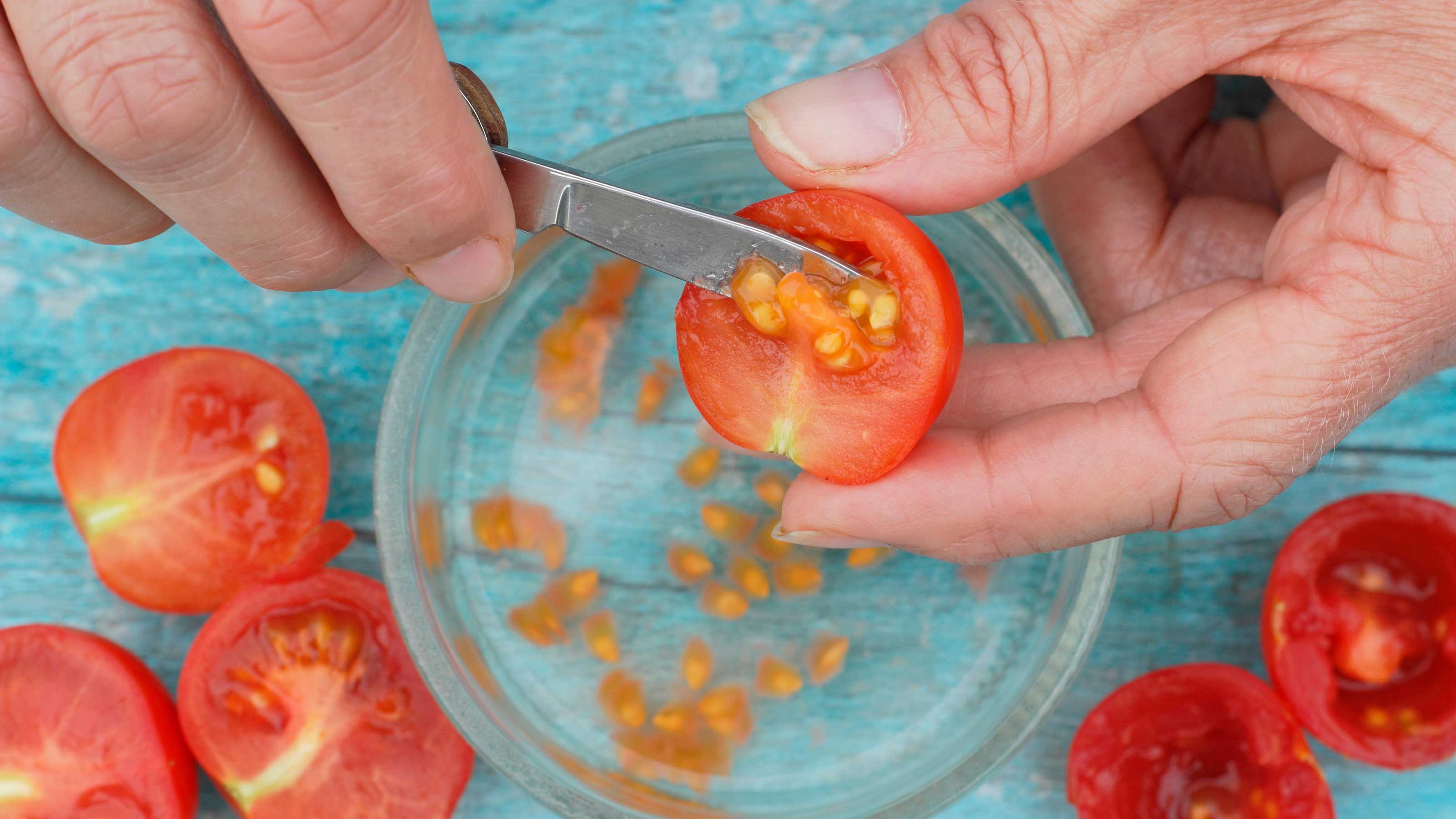Home>Gardening Techniques>How To Grow Greenhouse Tomatoes
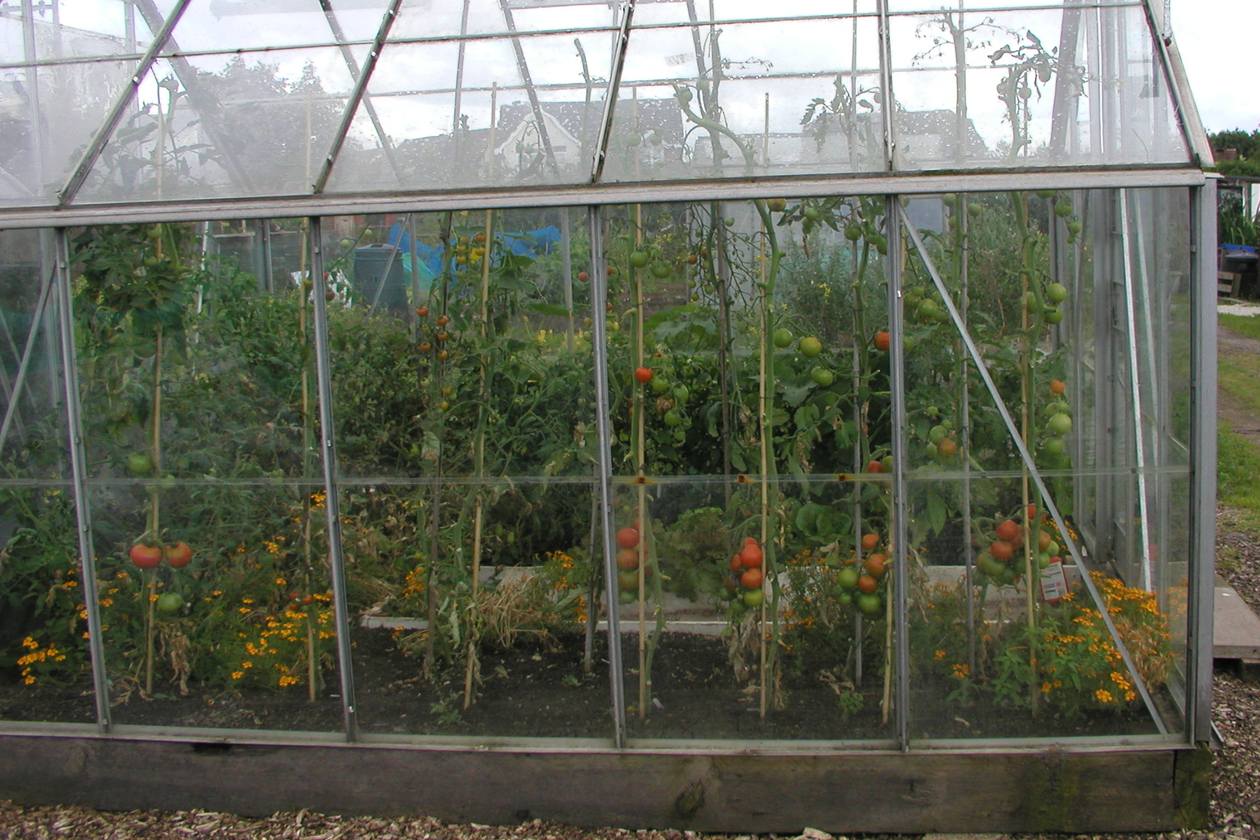

Gardening Techniques
How To Grow Greenhouse Tomatoes
Modified: January 22, 2024
Learn essential plant care tips to successfully grow greenhouse tomatoes and achieve a bountiful harvest. Discover expert insights and techniques for optimal growth.
(Many of the links in this article redirect to a specific reviewed product. Your purchase of these products through affiliate links helps to generate commission for Chicagolandgardening.com, at no extra cost. Learn more)
Table of Contents
- Introduction
- Benefits of Growing Greenhouse Tomatoes
- Choosing the Right Greenhouse
- Selecting Tomato Varieties
- Preparing the Greenhouse
- Planting Tomato Seedlings
- Providing Proper Lighting
- Maintaining Optimal Temperature and Humidity
- Watering and Fertilizing Techniques
- Pruning and Training Tomato Plants
- Pest and Disease Prevention and Control
- Harvesting and Storing Greenhouse Tomatoes
- Conclusion
Introduction
Welcome to the world of greenhouse tomato gardening! Whether you’re a seasoned green thumb or a newbie to the plant care world, growing tomatoes in a greenhouse is an exciting and rewarding endeavor. Not only does it allow you to extend the growing season and have a bountiful harvest, but it also provides the ideal environment for tomato plants to thrive.
Greenhouse tomatoes offer several advantages over traditional outdoor gardening. Firstly, you have complete control over the growing conditions, including temperature, humidity, and lighting. This allows you to create the perfect environment for your tomato plants, resulting in healthier and more productive crops. Secondly, growing tomatoes in a greenhouse provides protection from unpredictable weather conditions, pests, and diseases, increasing your chances of a successful harvest. Lastly, greenhouse tomatoes are known for their superior flavor and quality, making them a favorite amongst gardeners and chefs alike.
Choosing the right greenhouse is crucial for successful tomato cultivation. There are various types and sizes available, including glass, polycarbonate, and hoop houses. Consider factors such as available space, budget, and your specific gardening needs when selecting a greenhouse. Ensure that it provides adequate ventilation and insulation to maintain optimal growing conditions.
Next, selecting the right tomato variety is vital. There are countless options to choose from, including cherry tomatoes, beefsteak, heirlooms, and hybrids. Consider factors such as taste, size, disease resistance, and suitability for greenhouse growing when making your selection. It’s always a good idea to read seed catalogs, consult local gardening experts, or seek advice from experienced greenhouse growers.
Preparing your greenhouse is the groundwork for a successful tomato crop. Thoroughly clean and sanitize the structure to prevent the spread of diseases. It’s essential to ensure proper drainage and a well-prepared soil mix that is rich in nutrients. Providing proper lighting, maintaining optimal temperature and humidity levels, watering techniques, pruning, pest and disease prevention, and proper harvesting and storing methods are all key aspects of greenhouse tomato gardening that we will explore further in this article.
So, buckle up and get ready to dive into the wonderful world of greenhouse tomatoes. With the right knowledge and techniques, you’ll soon be enjoying a bountiful harvest of delicious, homegrown tomatoes that you can be proud of.
Benefits of Growing Greenhouse Tomatoes
Growing tomatoes in a greenhouse offers a wide array of benefits for gardeners and plant enthusiasts. Whether you have limited space or simply want to optimize your tomato crop, here are some of the key advantages of greenhouse tomato gardening.
Extended Growing Season: One of the primary benefits of a greenhouse is the ability to extend the growing season. By creating a controlled environment, you can start planting tomato seedlings earlier in the year and continue harvesting well into the fall. This means you can enjoy fresh, homegrown tomatoes for a longer period, even in regions with shorter growing seasons.
Protection from Weather Variations: Greenhouses provide a shield against unpredictable weather conditions. With a greenhouse, you no longer have to worry about sudden temperature drops, frost, excessive rain, or high winds damaging your tomato plants. This protection ensures a more stable and consistent growing environment, which is essential for healthy plant development and higher yields.
Controlled Growing Conditions: In a greenhouse, you have complete control over the growing conditions. This includes regulating temperature, humidity levels, and air circulation. Tomatoes thrive in warm environments, and a greenhouse allows you to maintain the ideal temperature range for optimal growth. You can also control the humidity levels, which is particularly beneficial to prevent diseases like powdery mildew.
Pest and Disease Prevention: Another advantage of growing tomatoes in a greenhouse is the reduction in pest and disease pressure. In an enclosed environment, you can prevent common tomato pests, such as aphids, hornworms, and whiteflies, from infesting your plants. Additionally, diseases that are spread through wind or rain, such as blight and fusarium wilt, are less likely to affect your crop.
Improved Crop Quality: Greenhouse-grown tomatoes are known for their superior flavor, texture, and appearance. The controlled environment allows for optimal nutrient uptake, resulting in more vibrant colors, sweeter taste, and juicier fruits. Furthermore, greenhouse tomatoes tend to have fewer blemishes and imperfections compared to their outdoor counterparts, making them a favorite choice for chefs and home cooks.
Maximized Yield: With the ability to control various environmental factors, greenhouse tomato gardening ensures higher yields compared to traditional outdoor methods. You can optimize light exposure by using proper shading techniques and supplemental lighting if needed. This promotes consistent growth and maximizes fruit production, giving you a more abundant harvest.
Year-Round Gardening: Some greenhouses are equipped with heating systems, allowing you to grow tomatoes throughout the year. This is particularly advantageous for commercial growers who want to provide a continuous supply of fresh tomatoes to the market. Even for home gardeners, the option of year-round gardening in a greenhouse opens up opportunities to experiment with different tomato varieties and enjoy the fruits of your labor all year long.
These benefits illustrate why greenhouse tomato gardening has become increasingly popular among plant lovers. Whether you’re a beginner or an experienced gardener, the advantages of growing tomatoes in a greenhouse are undeniable. By harnessing the power of controlled environments and utilizing proper techniques, you can enjoy a successful and rewarding tomato growing experience.
Choosing the Right Greenhouse
When it comes to greenhouse tomato gardening, choosing the right greenhouse is a critical first step. The greenhouse design and structure will directly impact the success and productivity of your tomato plants. Here are some key factors to consider when selecting a greenhouse for growing tomatoes.
Size and Space: Evaluate the available space in your garden or backyard before deciding on the size of the greenhouse. Consider how many tomato plants you plan to grow and whether you’ll need additional space for other crops or gardening equipment. It’s important to choose a greenhouse that provides ample room for your tomato plants to grow and allows for comfortable access and maneuverability.
Material: Greenhouses are typically constructed with either glass, polycarbonate, or plastic. Each material has its unique advantages and considerations. Glass greenhouses offer excellent durability and light transmission but tend to be more expensive. Polycarbonate greenhouses are lightweight, provide good insulation, and are more affordable. Plastic greenhouses are the least expensive option but may not offer the same longevity or insulation properties as the other materials.
Ventilation: Proper ventilation is crucial for maintaining a healthy growing environment for your tomatoes. Look for a greenhouse that provides ample ventilation options, such as adjustable vents, windows, or roof vents. This will allow you to control the airflow inside the greenhouse, preventing excessive heat buildup and providing fresh air circulation for the plants.
Insulation: Greenhouses need sufficient insulation to retain heat during colder months and protect plants from extreme temperatures. Insulated greenhouses help maintain a stable and consistent growing environment, which is especially important for tomato plants. Consider the type of insulation used in the greenhouse walls and roof, as well as additional insulation options like double-glazed windows or bubble wrap insulation.
Structural Stability: The stability and durability of the greenhouse are crucial, especially in areas prone to strong winds, heavy snowfall, or other extreme weather conditions. Look for a greenhouse with a sturdy frame and anchoring system to ensure it can withstand these weather elements. Additionally, a greenhouse with a steep roof pitch will help shed snow and prevent excessive weight accumulation.
Budget: Set a budget for your greenhouse project and consider the long-term costs. While investing in a high-quality greenhouse may require a larger upfront investment, it can save you money in the long run by providing better insulation, durability, and functionality. Consider the maintenance costs, such as heating, cooling, and repairs, when evaluating the total cost of ownership.
Additional Features: Depending on your specific needs, consider additional features that can enhance your greenhouse experience. This includes benches or shelving for organizing your plants, irrigation systems for efficient watering, or shade cloth for regulating light intensity. These features can make greenhouse tomato gardening more convenient and enjoyable.
Consulting with greenhouse experts or visiting local garden centers can provide valuable insights and guidance in selecting the right greenhouse for your tomato-growing needs. Take the time to evaluate all the factors mentioned above and choose a greenhouse that best suits your space, budget, and desired functionality. With the right greenhouse, you’ll be well on your way to creating the perfect environment for your tomato plants to flourish.
Selecting Tomato Varieties
When it comes to greenhouse tomato gardening, selecting the right tomato varieties is crucial for a successful and fruitful harvest. With countless options available, it’s important to consider several factors before making your selection. Here are some key factors to keep in mind when choosing tomato varieties for your greenhouse.
Taste: Tomato varieties vary in flavor profiles, ranging from sweet and mild to tangy and robust. Consider your personal preferences and the intended use of the tomatoes. Some varieties are ideal for eating fresh, while others are better suited for sauces, salads, or preserving. Farmer’s markets, local nurseries, and seed catalogs are great resources for discovering new and unique tomato flavors.
Size: Tomato plants come in various sizes, from the compact determinate varieties (bushy, stop-growing once fruit sets) to indeterminate varieties (vines, keep growing and setting fruit until frost). Choose the size that suits your greenhouse space and gardening style. Indeterminate varieties may require staking or trellising to support their vigorous growth, while determinate varieties are more compact and can be grown in containers.
Ripening Time: Consider the ripening time of the tomato varieties to ensure a steady supply of fruit throughout the growing season. Different tomato varieties have varying maturity dates, with some early-maturing varieties ready for harvest within 60-70 days while others may take 80-90 days or longer. Choosing a mix of early, mid, and late-season varieties can provide a continuous harvest over an extended period.
Disease Resistance: Some tomato varieties are bred with specific disease resistance, making them more tolerant or resistant to common tomato diseases such as fusarium wilt, late blight, or verticillium wilt. Disease-resistant varieties help minimize the risk and severity of diseases, especially in enclosed environments like greenhouses. Keep an eye out for letters or codes on seed packets that indicate resistance to specific diseases.
Growth Habit: Consider the growth habit of the tomato varieties, especially if you plan to train or prune your plants. Some varieties naturally have more compact and manageable growth habits, making them easier to train and support. Other varieties produce long, sprawling vines that require more space or trellising. Determinate varieties may be better suited for those who prefer a more orderly and controlled garden.
Availability of Seeds or Transplants: Determine whether you plan to start your tomato plants from seeds or purchase transplants. Some rare or heirloom varieties may only be available as seeds, while popular varieties are often readily available as transplants at local nurseries or garden centers. Consider your level of experience and the time you have available for seed starting if you opt for starting plants from seeds.
Climate Suitability: Take into account your specific climate and the greenhouse conditions when selecting tomato varieties. Some varieties are more heat-tolerant, while others thrive in cooler climates. Regional gardening resources, local gardening communities, and experienced gardeners in your area can provide valuable insights on which tomato varieties perform well under similar growing conditions.
Remember, the selection of tomato varieties for your greenhouse will largely depend on your personal preferences, available space, and growing conditions. Experimenting with different varieties can be an exciting and rewarding experience. Don’t be afraid to try new and unique tomato varieties to discover your own favorites. With careful consideration and a bit of experimentation, you’ll be able to find the perfect tomato varieties that thrive in your greenhouse environment.
Preparing the Greenhouse
Preparing your greenhouse is a crucial step in successfully growing tomatoes. Proper preparation ensures that the greenhouse provides an optimal environment for your plants to thrive. Here are some key steps to take when preparing your greenhouse for tomato cultivation.
Clean and Sanitize: Start by thoroughly cleaning and sanitizing the entire greenhouse structure. Remove any debris, weeds, or old plant material that may harbor pests or diseases. Disinfect all surfaces, including the walls, benches, and equipment, using a diluted bleach solution or commercial greenhouse disinfectant. This helps reduce the risk of pests and diseases from carrying over to the new growing season.
Check Drainage: Proper drainage is vital for greenhouse tomatoes. Ensure that your greenhouse has an efficient drainage system in place to prevent waterlogged soil, which can lead to root rot and other moisture-related issues. Check the drainage channels and clear any debris or blockages that may impede the flow of excess water.
Soil Preparation: Prepare the soil or growing medium in your greenhouse for optimal plant growth. Remove any old or spent soil and replace it with fresh, well-draining soil mix. Consider adding organic matter, such as compost or well-rotted manure, to improve soil fertility and structure. Conduct a soil test to assess nutrient levels and pH, and amend the soil as needed to create the ideal growing conditions for tomatoes.
Adequate Lighting: Tomatoes require plenty of sunlight to grow and produce healthy fruits. Position your greenhouse in a location that receives maximum sunlight exposure throughout the day. If you have limited natural light or are growing in a greenhouse with limited light transmission, consider supplemental lighting options such as grow lights. Adequate lighting ensures that your tomato plants receive sufficient energy for photosynthesis and promotes strong, vigorous growth.
Temperature Control: Maintaining an optimal temperature range is crucial for greenhouse tomatoes. Monitor and regulate the temperature inside the greenhouse using a combination of ventilation, shading, and heating systems. Install fans or vents to facilitate air circulation and control excessive heat buildup. During colder months, use greenhouse heaters or heating mats to ensure the temperature stays within the appropriate range for tomato growth.
Humidity Management: Tomatoes prefer moderate to high humidity levels, but excessive moisture can lead to fungal diseases. Proper humidity management is essential for greenhouse tomato cultivation. Install humidity monitors or hygrometers inside the greenhouse to keep track of humidity levels. Utilize techniques such as proper spacing between plants, adequate air circulation, and watering practices that reduce excess moisture on foliage and in the growing environment.
Support Structures: Tomato plants require support to grow upright and prevent sprawling. Install trellises, stakes, or cages in the greenhouse to provide support as the plants grow. Sturdy supports help maintain the shape and structure of the plants, promote proper air circulation, and make harvesting and maintenance tasks easier.
Organize and Optimize Space: Plan the layout of your greenhouse to optimize space utilization. Consider factors such as plant spacing, access pathways, and proper arrangement of benches or containers. Organizing the greenhouse helps maximize sunlight exposure, airflow, and ease of maintenance activities such as pruning, watering, and harvesting.
By following these steps and properly preparing your greenhouse, you’ll create an ideal environment for growing robust and productive tomato plants. Taking the time to prepare the greenhouse sets the stage for a successful tomato-growing season and increases the chances of a bountiful harvest.
Planting Tomato Seedlings
Planting tomato seedlings in your greenhouse is an exciting step towards a successful tomato harvest. Proper care during this stage sets the foundation for healthy plants and abundant fruit production. Here are some essential steps to follow when planting tomato seedlings in your greenhouse.
Choose Healthy Seedlings: Start by selecting healthy and vigorous tomato seedlings from a reputable nursery or by starting them from seeds. Look for strong stems, dark green leaves, and well-developed root systems. Avoid seedlings with any signs of diseases, pests, or leggy growth.
Transplant at the Right Time: Timing is crucial when transplanting tomato seedlings. Wait until the threat of frost has passed and the soil has warmed up to around 60°F (15°C) before transplanting. This ensures that the seedlings can establish and grow without the stress of cold temperatures.
Prepare the Planting Holes: Dig planting holes in the prepared soil or growing media with a trowel or your hands. Make the holes deep enough to accommodate the root system and ensure that the top leaves will be at or slightly above the soil surface. Space the planting holes according to the recommended spacing for the chosen tomato variety.
Provide Proper Support: If you’re growing indeterminate tomato varieties, provide adequate support for the plants at the time of transplanting. Insert stakes or set up trellises or cages in each planting hole to provide support as the plants grow. This prevents damage to the roots or stems later in the season.
Water the Seedlings: Before transplanting, water the seedlings gently to ensure they are well-hydrated. This helps minimize transplant shock and allows for better root establishment. Do not overwater the seedlings, as excessively wet soil can lead to root rot.
Plant the Seedlings: Carefully remove each seedling from its container or seedling tray, being cautious not to damage the delicate roots. Place the seedling in the prepared planting hole, ensuring that the roots are covered with soil. Gently firm the soil around the seedling to eliminate air pockets and provide stability.
Water the Transplanted Seedlings: After planting, water the seedlings thoroughly to help settle the soil around the roots. Ensure that the water reaches the root zone and is absorbed by the soil. This encourages root establishment and helps the seedlings recover from any transplant shock they may experience.
Provide Proper Care: After transplanting, continue to provide optimal care for your tomato seedlings. Monitor soil moisture levels and water when necessary to keep the soil evenly moist, but not saturated. Maintain proper temperature, humidity, and light levels in the greenhouse to promote healthy growth. Consider using organic fertilizers specifically formulated for tomatoes to provide the necessary nutrients for vigorous development.
Monitor for Pests and Diseases: Keep a close eye on your tomato seedlings for any signs of pests or diseases. Inspect the leaves, stems, and underside of the foliage regularly. Early detection and prompt action can prevent the spread of pests or diseases and help protect your plants from damage.
By following these steps and giving proper attention to the planting process, you’ll give your tomato seedlings the best start possible. Remember to provide ongoing care, including watering, fertilizing, and monitoring, as your plants grow. With time and diligent care, your tomato seedlings will flourish into healthy plants that produce a bountiful harvest of delicious tomatoes.
Providing Proper Lighting
Proper lighting is crucial for the successful growth of tomato plants in a greenhouse. As natural sunlight may be limited or inconsistent, providing supplemental lighting ensures that your plants receive the optimal amount of light for photosynthesis and healthy development. Here are some key factors to consider when providing proper lighting for your greenhouse tomatoes.
Understanding Light Requirements: Tomato plants require a minimum of 8-10 hours of direct sunlight per day for optimal growth and fruit production. However, in a greenhouse, the availability and intensity of natural sunlight may vary. Understanding the light requirements of different tomato varieties can help you determine the level of supplemental lighting needed.
Choosing the Right Light Source: There are various types of artificial light sources available, including fluorescent, LED (Light Emitting Diode), and high-intensity discharge (HID) lights. LED lights are the most energy-efficient option, producing a full spectrum of light suitable for plant growth. They also emit less heat, reducing the risk of leaf burn. Determine the specific needs of your tomato plants and select the light source that best suits your budget and greenhouse setup.
Placement of Lights: Proper placement of supplemental lights is essential to ensure uniform light distribution throughout the canopy of your tomato plants. Hang the lights directly over the plants, ensuring that they are at an adequate height to cover the entire growing area. Adjust the height as the plants grow to maintain an appropriate light intensity and prevent stretching or leaf burn.
Light Intensity: Tomato plants require a specific light intensity for optimal growth. The recommended intensity is typically measured in foot-candles or lux. Different growth stages of tomato plants require varying light intensities. For younger seedlings, a lower light intensity of around 1500-2000 lux is sufficient. As the plants mature and start flowering, increase the light intensity to 3000-4000 lux to promote fruit set and development.
Light Duration: Providing an appropriate duration of supplemental lighting is essential for maintaining a consistent light cycle and promoting healthy growth. For tomato plants, a light duration of 14-16 hours per day is usually sufficient. Aim for consistency in light schedules to avoid confusing the plants, as abrupt changes in light duration can stress them and affect their growth.
Light Spectrum: Tomato plants require a balanced spectrum of light for optimal growth. The spectrum includes blue light (400-500 nm) for foliage development and red light (600-700 nm) for flowering and fruiting. LED lights can be customized to provide the ideal spectrum for tomato plants, or you can use a combination of warm white and cool white fluorescent tubes to cover the full spectrum.
Lighting Maintenance: Regularly inspect and clean the light fixtures to ensure they are functioning properly. Dust and debris can accumulate on the light surfaces, reducing their effectiveness. Replace any damaged or faulty bulbs promptly to maintain consistent light intensity and spectrum. Ongoing maintenance ensures that your plants receive the maximum benefit from the supplemental lighting.
Lighting Cost and Efficiency: It’s essential to consider the cost and energy efficiency of supplemental lighting for your greenhouse. LED lights, although initially more expensive, are highly energy-efficient and have a longer lifespan, resulting in lower electricity bills and reduced maintenance costs over time. Consider calculating the long-term costs and benefits when selecting the lighting system for your greenhouse.
Providing proper lighting is crucial for the success of your greenhouse tomatoes. Supplemental lighting ensures that your plants receive the necessary light for photosynthesis, growth, and fruit production. By understanding the light requirements of your tomato plants and implementing the appropriate lighting strategy, you can create an optimal growing environment that allows your tomatoes to thrive and produce a bountiful harvest.
Maintaining Optimal Temperature and Humidity
Maintaining the optimal temperature and humidity levels in your greenhouse is crucial for the successful cultivation of tomato plants. These environmental factors play a vital role in their growth, flowering, and fruit production. Here are some key considerations for maintaining optimal temperature and humidity in your greenhouse.
Temperature Control: Tomatoes thrive in warm temperatures, typically between 70°F and 85°F (21°C to 29°C). Ensure that your greenhouse maintains a consistent temperature within this range. Consider using a combination of heating and cooling systems, such as fans, vents, and even environmental control systems, to achieve and maintain the desired temperature. Monitor the temperature regularly and make adjustments as needed to prevent extreme heat or cold stress.
Heat Management: In warmer climates or during the summer months, excessive heat can be detrimental to tomato plants. Adequate ventilation, shading, and evaporative cooling techniques can help regulate the temperature inside the greenhouse. Install exhaust fans or vents to promote air circulation and remove excess heat. Use shading materials or shade cloths to reduce excessive sunlight and heat exposure during the hottest parts of the day.
Cold Protection: Temperature drops, especially during the cooler months or at night, can negatively impact tomato plants. Insulate your greenhouse and seal any gaps or drafts to minimize heat loss. Consider using greenhouse heaters or heating mats to maintain the temperature above the desired minimum for tomato plants. Keep in mind that even mild drops in temperature can affect plant growth and slow down fruit development.
Humidity Regulation: Tomato plants prefer moderate to high humidity levels, ranging from 60% to 80%. However, excessive humidity can create favorable conditions for diseases such as powdery mildew. Monitor humidity levels in your greenhouse using hygrometers and provide proper ventilation to control excess moisture. Good air circulation and venting will help reduce humidity levels and prevent the buildup of dampness that can lead to diseases.
Watering Techniques: Proper watering is essential for maintaining optimal humidity levels and preventing water stress in tomato plants. Water the plants at the base, avoiding the foliage, to minimize moisture buildup on leaves and reduce the risk of diseases. Irrigation systems such as drip irrigation, soaker hoses, or self-watering containers can help deliver water directly to the root zone, preventing excessive moisture on the leaves and stems.
Misting: In hot and dry climates or during periods of low humidity, misting can help increase humidity levels around tomato plants. Use a fine mist nozzle or a misting system to moisten the air without saturating the plants. Misting can be done during the early morning or evening when the temperatures are cooler, and it allows the water to evaporate gradually.
Avoiding Temperature Fluctuations: Sudden and drastic temperature fluctuations can stress tomato plants and affect their overall growth and productivity. Limit temperature fluctuations by maintaining consistent temperature levels throughout the day and night. Implement proper insulation and shading techniques to minimize the impact of external weather conditions on the greenhouse environment.
Monitoring and Adjusting: Regular monitoring of temperature and humidity levels inside the greenhouse is crucial. Use digital thermometers and hygrometers to keep track of these factors. Make adjustments as needed to maintain the optimal range for tomato plants. Consider using automated environmental control systems that can monitor and regulate temperature and humidity levels based on your specified parameters.
By actively maintaining optimal temperature and humidity levels in your greenhouse, you create an environment that promotes healthy growth and maximum productivity for your tomato plants. Regular monitoring, proper ventilation, careful watering, and utilizing shading or heating systems when necessary will help ensure that your tomato plants thrive and produce a bountiful harvest.
Watering and Fertilizing Techniques
Proper watering and fertilizing techniques are essential for the successful growth and development of tomato plants in a greenhouse. These practices ensure that your plants receive the necessary nutrients and hydration they need to thrive. Here are some key considerations for watering and fertilizing your greenhouse tomatoes.
Watering: Tomato plants require consistent moisture to promote healthy growth and fruit production. Here are some watering techniques to ensure optimal hydration:
- Deep Watering: Watering deeply encourages the growth of deep roots, which are essential for accessing nutrients and water in the soil. Apply water directly to the root zone, making sure the soil is evenly moist.
- Avoid Overwatering: While consistent moisture is important, overwatering can lead to root rot and other water-related problems. Water the plants when the top inch of soil feels dry, and allow the soil to dry slightly between watering sessions.
- Mulching: Applying mulch around the base of your tomato plants helps retain soil moisture by reducing evaporation. Organic mulches like straw, wood chips, or compost can also provide additional nutrients and improve soil structure.
- Watering in the Morning: Water your plants in the morning to allow foliage to dry during the day, reducing the risk of diseases. Avoid overhead watering to prevent water from sitting on the leaves, which can promote the development of fungal infections.
Fertilizing: Tomato plants have specific nutrient requirements to support their growth and fruit production. Here are some fertilizing techniques to ensure your plants receive the necessary nutrients:
- Soil Testing: Conduct a soil test before planting to determine the nutrient levels in your greenhouse soil. Soil tests provide valuable information about the pH level and nutrient deficiencies, allowing you to customize your fertilizer applications.
- Choose the Right Fertilizer: Select a balanced fertilizer formulated for tomatoes or vegetables. Look for a fertilizer with an NPK (Nitrogen, Phosphorus, and Potassium) ratio suitable for the growth stage of your plants. Organic options like compost, well-rotted manure, or fish emulsion are also great choices.
- Preplant Fertilization: Before planting your tomato seedlings, incorporate a slow-release fertilizer or well-rotted compost into the soil. This helps provide a steady supply of nutrients as the plants grow.
- Side-Dressing: As your tomato plants grow, apply additional fertilizer in the form of side-dressing. Sprinkle granular fertilizer along the side of the planting row or trench, being careful to keep the fertilizer away from the plant stems to avoid burning.
- Foliar Feeding: Supplementing with foliar sprays can provide a quick nutrient boost. Dilute a liquid fertilizer, seaweed extract, or compost tea and spray it directly onto the foliage. This method allows the plants to absorb nutrients through their leaves.
Monitoring and Adjustments: Regularly monitor the condition of your tomato plants, as well as the soil moisture and nutrient levels. Adjust your watering and fertilizing practices accordingly based on the specific needs of your plants. Keep in mind that factors like plant size, stage of growth, weather conditions, and the type of growing medium used can influence the frequency and amount of water and fertilizer required.
Proper watering and fertilizing techniques are essential for maintaining the health and productivity of your greenhouse tomato plants. Consistent and balanced practices will provide them with the necessary hydration and nutrients to thrive and produce delicious, homegrown tomatoes.
Pruning and Training Tomato Plants
Pruning and training tomato plants are essential practices that help promote healthier growth, improve air circulation, and maximize fruit production in a greenhouse setting. By following proper techniques, you can ensure that your tomato plants are well-structured, easier to manage, and more productive. Here are some key considerations for pruning and training your greenhouse tomato plants.
Why Prune: Pruning involves removing unwanted shoots, leaves, and branches from the tomato plants. It helps redirect the plant’s energy towards fruit production and improves airflow through the canopy, reducing the risk of diseases. Pruning also prevents overcrowding, allowing more sunlight to reach the lower parts of the plant and promoting even ripening of the fruit.
When to Prune: The timing of pruning depends on the growth stage of the tomato plant and the desired shape. Start pruning when the plants have developed a few sets of true leaves, usually a few weeks after transplanting. Regularly monitor your plants and prune as needed throughout the growing season.
Suckering: One of the main pruning techniques for tomato plants is removing suckers. Suckers are the small shoots that develop in the axils between the main stem and the branches. To control the plant’s growth and promote stronger branches, pinch off the suckers when they are small, using your fingers or a clean pair of pruning shears. Leave one or two main stems and remove any additional suckers.
Determinate vs. Indeterminate Varieties: Different tomato varieties have varying growth habits. Determinate varieties naturally have a more compact growth habit and do not require extensive pruning. Indeterminate varieties, on the other hand, tend to grow vigorously and benefit from pruning and training. Refer to the variety’s characteristics or consult seed catalogs to determine the appropriate pruning approach.
Training Techniques: Training tomato plants involves guiding their growth and supporting them to maintain an organized and manageable structure. Here are some common training techniques:
- Staking: Stake the tomato plants by gently tying the main stem to a stake. This method provides support and helps ensure the plant grows upright. As the plant grows, continue to tie the main stem to the stake at regular intervals.
- Trellising: Use a trellis system to support the growth of indeterminate tomato varieties. Install a trellis at the back of the plant row and attach the main stem or branches to the trellis using twine or plant clips. Regularly secure the plants to the trellis as they grow, redirecting branches and promoting upward growth.
- Caging: Place cylindrical wire cages around individual tomato plants for support. As the plants grow, gently guide the branches through the openings in the cages. This method allows the plants to grow within the structure, supporting themselves as they gain height and develop fruit.
Pruning Tips:
- Remove Lower Leaves: As the tomato plants grow, remove the lower leaves that come into contact with the soil. This reduces the risk of soil-borne diseases and pests and improves airflow around the plant.
- Remove Diseased or Damaged Foliage: Routinely inspect your tomato plants and promptly remove any yellowing, wilted, or diseased foliage. Removing these leaves helps prevent the spread of diseases and ensures a healthier plant.
- Avoid Overpruning: While pruning is beneficial, it’s important not to go overboard. Avoid excessive pruning that can stress the plant and hinder its ability to photosynthesize effectively. Strike a balance between removing excess growth and maintaining enough foliage for energy production.
- Prune Outward-Facing Leaves: When trimming larger branches, remove leaves that face inward towards the plant’s center. This helps increase ventilation and sunlight exposure to the inner parts of the plant.
Pruning and training tomato plants in a greenhouse require patience and attention to detail. Regular monitoring, gentle pruning, and proper training techniques will help your tomato plants thrive, develop a well-organized structure, and yield a bountiful harvest of delicious tomatoes.
Pest and Disease Prevention and Control
Pests and diseases can pose a significant threat to greenhouse tomato plants. It is crucial to implement preventive measures and promptly address any issues to safeguard the health and productivity of your plants. By following proper prevention and control strategies, you can minimize the risk of pests and diseases and ensure the success of your greenhouse tomato garden. Here are some key considerations for pest and disease prevention and control.
Preventive Measures:
- Sanitation: Maintain cleanliness and remove any debris, fallen leaves, or plant residues from the greenhouse. These can serve as breeding grounds for pests and diseases.
- Quarantine: Isolate new plants or seedlings for a few days before introducing them into the greenhouse. This allows you to observe them for any signs or symptoms of pests or diseases.
- Proper Watering: Avoid overwatering and ensure that the greenhouse has good drainage. Excessive moisture can create favorable conditions for fungal diseases.
- Proper Ventilation: Provide adequate airflow within the greenhouse by using fans, vents, or open doors and windows. Good air circulation helps prevent the buildup of humidity and reduces the risk of diseases.
- Monitor Regularly: Conduct routine inspections of your tomato plants, checking for any signs of pests, disease symptoms, or abnormalities. Early detection increases the chances of successful pest and disease management.
Common Tomato Pests:
- Aphids: These small, sap-sucking insects can quickly multiply and cause foliage damage. Use insecticidal soap or a strong jet of water to remove them from the plants.
- Whiteflies: These tiny, flying insects feed on plant sap and cause yellowing, stunting, and the spread of viral diseases. Sticky traps, insecticidal soap, or neem oil can help control whitefly populations.
- Hornworms: These large, leaf-eating caterpillars can cause significant damage to tomato plants. Handpick and destroy them or use organic insecticides for control.
- Spider Mites: These minuscule pests suck plant sap, causing yellowing leaves and webbing. Spray the plants with a strong jet of water or use insecticidal soap to control spider mite infestations.
Common Tomato Diseases:
- Early Blight: This fungal disease causes dark spots on leaves, which gradually turn yellow and wither. Rotate crops, maintain proper spacing between plants, and apply copper-based fungicides for control.
- Late Blight: Late blight causes water-soaked lesions on leaves, stems, and fruit. Good airflow, spacing, and regular applications of fungicides approved for late blight management can help control the disease.
- Fusarium Wilt: This soil-borne disease causes wilting, yellowing, and eventual death of the plant. Plant resistant varieties and practice crop rotation to minimize the risk of fusarium wilt.
- Powdery Mildew: Powdery mildew appears as white, powdery patches on leaves and stems. Enhance air circulation, avoid overhead watering, and apply fungicides to prevent and manage powdery mildew.
Organic Pest and Disease Control:
- Beneficial Insects: Introduce beneficial insects like ladybugs or lacewings, as they prey on pests like aphids and whiteflies.
- Neem Oil: Neem oil is an organic insecticide and fungicide that helps control a variety of pests and diseases.
- Biological Sprays: Use biological sprays containing beneficial bacteria or fungi that combat specific pests or diseases.
Integrated pest management (IPM) practices combine preventive measures, regular monitoring, and targeted control methods to manage pests and diseases effectively. By implementing these strategies and using a combination of cultural, organic, and chemical control methods when necessary, you can maintain a healthy and productive greenhouse tomato garden.
Harvesting and Storing Greenhouse Tomatoes
Harvesting greenhouse tomatoes at the right time and storing them properly ensures that you can enjoy the fruits of your labor for an extended period. Here are some key considerations for harvesting and storing your greenhouse tomatoes:
Harvesting:
- Timing: Harvest tomatoes when they are fully ripe but still firm. Different tomato varieties have varying ripening times, so keep track of the approximate days to maturity for each variety.
- Color and Texture: Look for uniform color and smooth skin when determining if a tomato is ripe. Avoid picking tomatoes that are overly soft or show signs of wrinkling or cracking.
- Harvesting Technique: To pick tomatoes without damaging the plant, hold the fruit gently and twist it until it separates from the stem. Alternatively, you can use garden shears or a sharp knife to cut the stem.
- Prune Yellow Leaves: While harvesting, remove any yellow or diseased leaves from the tomato plants to maintain cleanliness and prevent the spread of diseases.
Storing:
- Room Temperature: If you plan to consume the tomatoes within a few days, store them at room temperature away from direct sunlight. Placing them in a single layer on a countertop or a basket allows air to circulate and helps slow down the ripening process.
- Refrigeration: If you have more tomatoes than you can consume quickly, store them in the refrigerator. However, keep in mind that refrigeration can affect the flavor and texture of tomatoes. Allow refrigerated tomatoes to come to room temperature before eating to maximize their taste.
- Preservation: If you want to prolong the shelf life of your tomatoes, consider preserving them through canning, freezing, or making tomato-based sauces, salsas, or soups. Follow proper food preservation techniques for safe and long-term storage.
- Ripening: If you have picked green or partially ripe tomatoes, you can let them ripen further by placing them in a paper bag and storing them at room temperature. The ethylene gas produced by the tomatoes will help accelerate the ripening process.
Tips for Quality and Flavor:
- Avoid Overcrowding: To prevent premature spoilage, avoid overcrowding tomatoes during storage. Providing enough space between each fruit allows for better air circulation and reduces the likelihood of mold or decay.
- Handle with Care: Tomatoes have delicate skins and can bruise easily. Handle them gently to avoid causing damage that can lead to spoilage.
- Inspect Regularly: Check stored tomatoes regularly for any signs of mold, decay, or ripeness. Remove any spoiled or overripe tomatoes to prevent them from affecting the others.
- Separate Damaged Tomatoes: If you notice any damaged or rotten tomatoes, separate them from the healthy ones to prevent the spread of spoilage.
Following proper harvesting and storage practices ensures that you can enjoy the delicious taste of your greenhouse-grown tomatoes for as long as possible. With attention to timing, proper handling, and suitable storage methods, you can savor the flavors of your homegrown tomatoes well beyond the growing season.
Conclusion
Greenhouse tomato gardening offers a plethora of benefits, allowing you to extend the growing season, control the environment, and enjoy a bountiful harvest of flavorful tomatoes. By following the right techniques and practices, you can create the perfect environment for your tomato plants to thrive.
Choosing the right greenhouse, selecting the appropriate tomato varieties, and preparing the greenhouse for optimal growing conditions sets the foundation for successful tomato cultivation. Providing proper lighting, maintaining optimal temperature and humidity, and implementing proper watering and fertilizing techniques contribute to the health and productivity of your tomato plants.
Pruning and training your tomato plants, along with proactive pest and disease prevention and control, help promote vigorous growth and minimize yield loss. Lastly, harvesting your greenhouse tomatoes at the right time and storing them properly ensures that you can enjoy the fruits of your labor for an extended period.
As with any gardening endeavor, greenhouse tomato gardening requires attention, patience, and adaptability. Each tomato plant has its unique characteristics and may respond differently to various environmental factors. Monitoring and adjusting your techniques based on plant health and needs will help in achieving the best results.
So, go ahead and embark on your greenhouse tomato gardening journey with confidence. With the knowledge and skills gained from this complete guide, you are well-equipped to create a thriving greenhouse filled with delicious, homegrown tomatoes. Enjoy the experience, experiment with different varieties, and savor the rewards of your greenhouse tomato harvest!
